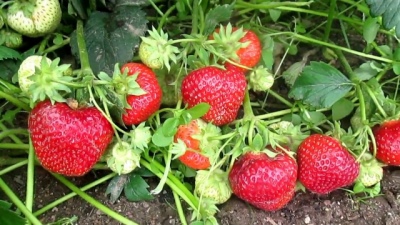
- Authors: Netherlands
- Name synonyms: Faith
- Taste: sweet
- The size: large
- Weight: 30-70 gr
- Yield rate: very high
- Yield: 0.7 kg per bush
- Ripening terms: late
- Appointment: fresh consumption
- Description of the bush: tall, spherical, thick
Over the past decades, breeders have managed to develop many new and sought-after varieties of strawberries, one of which is Faith, which means "faith". The fruits of the variety are in great demand, they are used for fresh consumption.
Description of the variety
Faith is bred by Dutch breeders.
It is characterized by absolute unpretentiousness, has open, powerful and beautiful spherical bushes, reaching a height of about 50 cm. At the time of ripening, the berries are located on the ground. The bush produces a lot of whiskers, thanks to the long flowering, extended harvest times are ensured.
Ripening terms
The plant is distinguished by its late ripening periods, which, depending on the region, begin in late July - early August.
Growing regions
Growing berries is recommended in any region of Ukraine, in the Volgo-Vyatka and West Siberian regions, as well as in the middle zone and in the south of Russia.
Yield
The plant has a high yield, during the season up to 700 g can be harvested from the bush. When harvested, the berry does not deform, it easily breaks off. Can be collected mechanically. After picking, the berry can be stored for about a week, it can be transported over long distances.
Berries and their taste
The berries are intensely red in color, rather large, have a rounded-conical shape with a very sweet taste and pronounced aroma. With proper care, the mass of one berry reaches 30-70 g. Thanks to the juicy and dense pulp, strawberries not only have decent taste characteristics, but also keep well under the scorching sun.
Growing features
Due to the fact that the bushes form a lot of mustaches, they must be removed in time. They provoke a thickening of the garden and a decrease in the size of the berries. Stable watering is the key to yield and fruit size; severe waterlogging or prolonged drought should not be allowed. It is especially necessary during the ovary period, and during harvesting it can be reduced, so the berry will be sweeter. Periodic loosening of the soil and removal of weeds are important measures - this will not only enrich the soil and roots with oxygen, but also prevent the development of pests.




Site selection and soil preparation
Strawberries prefer to grow on light to medium-textured soils. Before planting, it is necessary to carry out a deep digging of the site. Planting of seedlings is carried out in spring or autumn, when the soil warms up to +15 degrees, or a month before the onset of the first frost. The plot should be light and not shaded by trees. Strawberries should not be planted where tomatoes or potatoes were previously grown. Garlic or legumes are considered the best precursors.
It is necessary to leave a distance of at least 50 cm between the bushes, and the gap between the rows should be at least 70 cm. The seedlings are watered for 10 days until they take root. This variety is only used for outdoor cultivation.

Pollination
The variety needs pollination. The bees do an excellent job with this task.
Top dressing
Periodic dressing has a noticeable effect on the quality of the berry. For this, nitrogen-containing compounds are suitable, bird droppings or mullein will help improve the quality of the bush in the spring. Before flowering, you can feed it with nitroammophosphate, superphosphate or other similar fertilizers. To make the berry more sugary, potash can be added. To improve the ovary and prevent the inflorescences from falling off, you can spray the bushes with boron. Top dressing with wood ash is best used after fruiting.

One of the important techniques in strawberry care is feeding. Regular fertilization guarantees a rich harvest. There are several different ways to feed strawberries, and each of them is designed for a specific period of plant development. During flowering, fruiting and after it, feeding should be different.
Frost resistance and the need for shelter
Faith is a fairly winter-hardy variety, withstands frosts down to -20 degrees, but despite this, in regions where the temperature is below this, you need to use an additional covering layer. For this, coniferous spruce branches, straw, sawdust or agrofibre are suitable.

Diseases and pests
Strawberries are highly resistant to diseases and pests, especially powdery mildew and gray mold. However, if the drainage is disturbed or the soil is very moist, the roots can rot.
To prevent the occurrence of dangerous insects, you can plant additional beds of marigolds or calendula.
Slugs are very common pests. To destroy them, the bushes are sprinkled with tobacco dust or mustard powder. The same substances can be used for aqueous spray solutions. To prevent infection of the bush with infectious diseases, you can additionally treat it with a 1% solution of Bordeaux liquid. Spraying is carried out before flowering or after harvesting.

Strawberries are often subject to many dangerous diseases that can seriously undermine their condition.Among the most common are powdery mildew, gray mold, brown spot, anthracnose, and verticillosis. Before buying a variety, you need to inquire about its disease resistance.
Reproduction
The variety is distinguished by a strong adaptive ability, therefore, it is the mustache that is the best planting material. A young cut, which already has 3-4 leaves, is cut off from the main plant and transplanted to a permanent place of growth.

Review overview
Gardeners' reviews indicate that strawberries are distinguished by an exquisite taste and increased sweetness, beautiful external characteristics. During cultivation, it is quite unpretentious, and negative weather factors do not significantly affect the quality of the berries. Thanks to the increased whitening, the plantation can be easily expanded. The berries are excellently marketed.


















































































